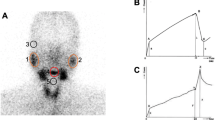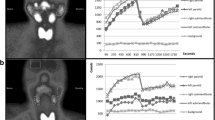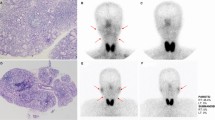Abstract
The aim of this study is to evaluate the diagnostic value of quantifying salivary gland scintigraphy in correlation to the labial biopsy findings of Sjögren’s syndrome (SS). Thirty patients suspected of having SS referred to our clinic for salivary gland scintigraphy were included to this study. All patients underwent salivary gland biopsy as well. The severity of histopathologic changes was graded according to the Chisholm and Mason scoring system. Dynamic scintigraphy was performed and region of interests (ROI) were drawn. Time activity curves for salivary glands were generated. Count rates of maximum, minimum activity after lemon juice stimuli, and last minute activities of parotid and submandibular glands were obtained. On the basis of this ROI counts, excretion fraction (EF%) was calculated for all salivary glands. The mean EF% for normal parotid gland and pathologic parotid gland was 54.5 ± 13.9 and 45.8 ± 18.42, respectively, while it was 46.7 ± 11.7 for the normal submandibular gland and 29.3 ± 18.8 for the pathologic submandibular gland. With progression in histopathologic grades from 0 to 4, the EF decreased in all salivary glands. Decreased EF in the salivary glands is correlated with the SS, and salivary gland scintigraphy is a sensitive and valid method for evaluation of the function of the salivary glands.




Similar content being viewed by others
References
Manoussakis MN, Moutsopoulos HM (2000) Sjögren’s syndrome: autoimmune epithelitis. Baillière’s Best Practice & Research Clin Rheumatol 14:73–95
Vitali C, Bombardieri S, Moutsopoulos HM (2002) Classification criteria for Sjögren’s syndrome: a revised version of the European criteria proposed by the Americane European consensus group. Ann Rheum Dis 61:554–558
Umehara I, Yamada I, Murata Y, Takahashi Y, Okada N, Shibuya H (1999) Quantitative evaluation of salivary gland scintigraphy in Sjögren’s syndrome. J Nucl Med 40:64–69
Schall GL, Anderson LG, Wolf RO et al (1971) Xerostomia in Sjögren’s syndrome: evaluation by sequential salivary scintigraphy. JAMA 216:2109–2116
Arrago JP, Rain JD, Brocheriou C, Rocher F (1987) Scintigraphy of the salivary glandsin Sjögren’s syndrome. J Clin Pathol 40:1463–1467
Daniels TE, Powell MR, Sylvester RA, Talal N (1979) An evaluation of salivaryscintigraphy in Sjögren’s syndrome. Arthritis Rheum 22:809–814
Sugihara T, Yoshimura Y (1988) Scintigraphic evaluation of the salivary glands in patients with Sjögren’s syndrome. Int J Oral Maxillofac Surg 17:71–75
Bohuslavizki KH, Brenner W, Wolf H et al (1995) Value of quantitative salivary gland scintigraphy in the early stage of Sjögren’s syndrome. Nucl Med Commun 16:917–922
Aung W, Yamada I, Umehara I, Ohbayashi N, Yoshino N, Shibuya H (2000) Sjögren’s syndrome: comparison of assessments with quantitative salivary gland scintigraphy and contrast sialography. J Nucl Med 41:257–262
Klutmann S, Bohuslavizki KH, Kröger S, Bleckmann C, Brenner W, Mester J et al (1999) Quantitative salivary gland scintigraphy. J Nucl Med Technol 27:20–26
Kosuda S, Suzuki K, Kawakami R, Akita S, Mezaki T, Inokuma S et al (1993) Reassessment of usefulness of salivary scintigraphy in diagnosis of Sjögren’s syndrome. Kaku Igaku (Jpn J Nucl Med) 30:161–170
Chisholm DM, Mason DK (1968) Labial salivary gland biopsy in Sjögren’s syndrome. J Clin Pathol 21:656–660
Liem IH, Olmos RA, Balm AJ et al (1996) Evidence for early and persistent impairment of salivary gland excretion after irradiation of head and neck tumours. Eur J Nucl Med 23:1485–1490
Kohn WG, Ship JA, Atkinson JC, Patton LL, Fox PC (1992) Salivary gland 99mTc-scintigraphy: a grading scale and correlation with major salivary gland flow rates. J Oral Pathol Med 21:70–74
Vigh L, Carlsen O, Hartling OJ (1997) Uptake index and stimulated salivary gland response in 99Tcm-pertechnetate salivary gland scintigraphy in normal subjects. Nucl Med Commun 18:363–366
Demangeat R, Didon-Poncelet A, Cherfan J, Demangeat JL (2000) Stimulated salivary pertechnetate clearance revisited: correlation with dynamic scintigraphic indices in sicca syndrome. Clin Nucl Med 25:888–894
Bohuslavizki KH, Brenner W, Tinnemeyer S et al (1995) Quantitative salivary gland scintigraphy derived from 166 normals. Radiol Oncol 29:297–305
Gerli R, Muscat C, Giasanti M et al (1997) Quantitative assessment of salivary gland inflamatory inflamation in primary Sjögren’s syndrome: its relationship to different demographic clinical and serological features of the disorder. Br J Rheumatol 36:969–975
Vinagre F, Santos MJ, Prata A, Canas da Silva J, Santos AI (2009) Assessment of salivary gland function in Sjögren’s syndrome: the role of salivary gland scintigraphy. Autoimmun Rev 8:672–676
Konttinen YT, Porola P, Konttinen LLA, Ne M, Poduval P (2006) Immunohistopathology of Sjögren’s syndrome. Autoimmun Rev 6:6–20
Disclosures
None.
Author information
Authors and Affiliations
Corresponding author
Rights and permissions
About this article
Cite this article
Aksoy, T., Kiratli, P.O. & Erbas, B. Correlations between histopathologic and scintigraphic parameters of salivary glands in patients with Sjögren’s syndrome. Clin Rheumatol 31, 1365–1370 (2012). https://doi.org/10.1007/s10067-012-2024-2
Received:
Revised:
Accepted:
Published:
Issue Date:
DOI: https://doi.org/10.1007/s10067-012-2024-2




